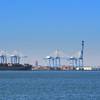Hapag-Lloyd Celebrates East Asia to Australia Milestone
In 1886, the up-and-coming German economy needed regular liner services connecting it with the new growth markets, in addition to efficient postal services around the world. To this end, the German Reich provided subsidies for the first Reichspost steamship liner services to East Asia and Australia totalling five million German mark annually with the aim of quite literally flying the flag in regions important for future growth. The contractually required standards that the shipping companies had to satisfy were thus correspondingly high: first-rate vessels, sailings every four weeks, high average rate of speed and, of course, Prussian punctuality.
By today’s standards, the Reichspost steamships seem comparatively small: the Oder of Norddeutscher Lloyd, one of the founding companies of Hapag-Lloyd, was approximately 107 metres long, 3,158 GRT in size, could carry 770 passengers and had a freight capacity of 1,600 tonnes. Nonetheless, when on 30 June 1886 the Oder set sail from Bremerhaven on its first ever service to East Asia, the Chinese ambassador was there in person to mark the occasion. The Salier, which began service for the Australia route on 14 July, had similar dimensions. By way of comparison, the Tsingtao Express, currently serving Hapag-Lloyd's Europe–East Asia route, is 335 metres long, has a capacity of up to 104,000 tonnes and can carry 8,750 standard containers.
With sailings every four weeks the steamships leaving from Bremerhaven served ports such as Suez, Aden, Colombo, Singapore, Hong Kong and Shanghai in the Far East and
Adelaide, Melbourne and Sydney in Australia. Feeder services were then available from Hong Kong to Japan (Yokohama, Nagasaki and Hyogo) as well as from Sydney to Samoa and Tonga. Other European ports were also served – Antwerp and Southampton, for example. Even in those days, cargoes bound for Asia and Australia were mainly industrial goods and, on the return journey to Europe, mainly commodities. Hapag, the second founding company of Hapag-Lloyd, began cooperating with Norddeutscher Lloyd at the turn of the century on the Reichspost steamship services to improve cost-efficiency, with the companies coordinating their sailing schedules as well.
To this day, as for over 125 years, East Asia is still one of Hapag-Lloyd’s most important trading routes. For decades it has always been served by the largest and most modern ships in the Company’s fleet. The ten new 13,200-TEU Hapag-Lloyd ships that are to be taken into service between June 2012 and the end of 2013 will also link Europe and East Asia. “With the vessels in this new size class we are continuing what we started 125 years ago: connecting Europe with the growth regions of the future in East Asia via fast and reliable liner services,” says Michael Behrendt, Chairman of the Executive Board of Hapag-Lloyd AG. “We are very proud of the long partnership between Hapag-Lloyd and its customers in East Asia – an economic area with great significance, strong growth and excellent perspectives.”
What began 125 years ago has grown into an extensive network of around 40 Hapag-Lloyd services to East Asia and Australia/New Zealand (from and to Europe and transpacific). In all, Hapag-Lloyd today links more than 160 ports on all continents directly with over 140 container vessels on around 80 services. Including the feeder network, the total number is over 430 ports in 112 countries. Nearly 6,900 employees in 114 countries ensure trouble-free shipping of more than five million standard (TEU) containers annually – over half of them in the East Asia and Australia trades.













